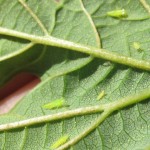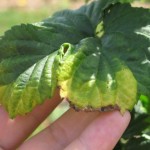
Adult female potato leafhoppers (Empoasca fabae) arrived to the Borderview research farm in Alburgh between May 23 and May 26. To identify them, stick your hand in a hop plant and ruffle it around–you may see light colored potato leafhoppers fly out. Whether you have seen potato leafhopper yet or not, it is time to start scouting your hop yard for arthropod pests.
The potato leafhopper is a migratory insect pest. The 2014 potato leafhopper population was scarce and did not peak until the end of July. In previous years, potato leafhopper arrived around June 1st and the population peaked earlier (late June to early July) which we can expect in 2015. Our potato leafhopper factsheet has more information on biology and symptoms.
Research we conducted last year showed that 3 adult potato leafhoppers per leaf reduced first year hop photosynthesis. We know this is a pest of concern, but we do not have an economic threshold for this pest on hops. The majority of (organic and non-organic) pesticides labeled for use against potato leafhopper are broad-spectrum products.

Broad-spectrum pesticides not only kill the target pests but also natural enemy arthropods. Therefore, we discourage the use of these broad-spectrum pesticides on hops due to the elevated risk of two-spotted spider mite outbreak. However, we have found that potato leafhoppers prefer to feed on red clover planted in the drive rows than on hop plants. This suggests that planting red clover in drive rows as a “trap crop” may reduce the number of leafhoppers on hop plants. If you give this a try, let us know!